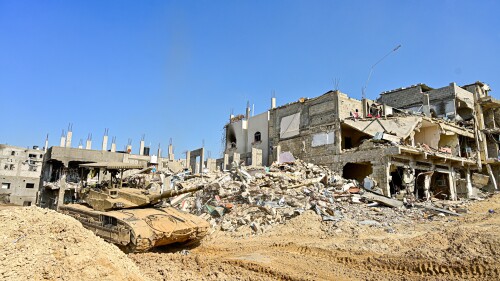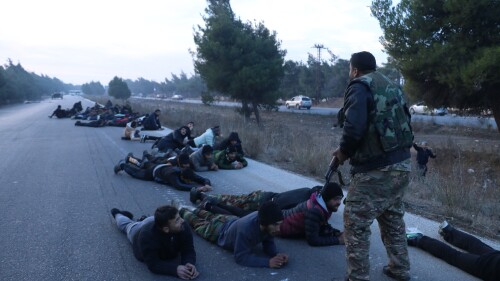Syria’s civil war is nearing its end — and an entirely new one is starting, with the United States at the center of it. |
The idea that Syria’s civil war is winding down has been repeated so often in recent months as to become a cliché. It has never been entirely true.
U.S. officials recently confirmed Washington’s intention to indefinitely retain effective ownership of around 28 percent of Syrian territory, in partnership with the Kurdish-led Syrian Democratic Forces. But those plans are increasingly in conflict with the other major international players in the war-torn country. That includes America’s erstwhile ally, Turkey, which recently launched “Operation Olive Branch,” an incursion into the Kurdish-held Afrin canton in Syria’s northwest. Meanwhile, President Bashar al-Assad’s regime is assaulting mainly Sunni Arab rebels to the south, and completing its conquest of the Abu Duhur airbase in the northern Idlib Province.
All this bloodshed doesn’t just spoil Washington’s plans — it also calls into question whether the participants in the Syrian war are anywhere close, to quote another cliché, to “bleeding themselves out.” Even if the dynamics driving the overlapping conflicts of Syria’s war are drawing to a close, they aren’t generating a peaceful and orderly future for long-suffering Syrians. Rather, new conflicts are emerging fully formed from the wombs of the old.
New conflicts are emerging fully formed from the wombs of the old.
Since mid-2014, there have been two parallel wars taking place on Syrian soil. The “original” war is the fight between the Sunni Arab rebels and the Bashar al-Assad regime, which is centered on the more densely populated area of western Syria. The second war is the contest between the Islamic State and the U.S.-led global coalition assembled against it.
Both these wars are indeed close to conclusion. The former war was decided in Assad’s favor on Sept. 30, 2015 — the day that Russian aircraft appeared over the skies of Syria. The rebellion, lacking any but the most rudimentary anti-aircraft capacity, has found itself helpless against the combination of Russian air power and Iran-supported and supplied manpower.
The regime’s survival, therefore, is no longer in doubt. But it is a different entity to the one that launched the war against anti-Assad protesters in the summer of 2011. Seven years later, the regime in Damascus is no longer about to dictate events in Syria as it once did, and instead it must defer to the wishes of those powers that ensured its survival.
Syrian President Bashar Assad’s survival is no longer in doubt, but he must defer to the wishes of those who ensured his survival. |
The events of recent days in Afrin offer an instructive example. Assad himself expressed his adamant opposition to the Turkish incursion, saying that "[t]he brutal Turkish aggression on the Syrian town of Afrin cannot be separated from the Turkish regime’s policy from the first day of Syria’s crisis, which was essentially built on supporting terrorism and terrorist organizations.”
Faisal Mekdad, the regime’s deputy foreign minister, told reporters in Damascus that Syria’s forces were “ready to destroy Turkish air targets in the skies of the Syrian Arab Republic.”
But Assad’s Russian patrons evidently took a different view of the Turkish operation. Russian military personnel in the Kurdish enclave were withdrawn prior to the commencement of the Turkish operation. Turkish aircraft currently being used to bomb Kurdish positions in the Afrin region could not have crossed the border without Russian permission, given the presence of two Russian S-400 air defense batteries guaranteeing that Moscow can rid Syria’s skies of any unwanted presence. Assad’s government was required by the actual decision-makers to tolerate this situation — and true to form, it has not followed through on its threat to shoot down Turkish jets.
Faylaq al-Sham (left), Nour al-Din al-Zenki (center), and the Levant Front (right) are effectively military contractors working on behalf of Turkish interests. |
Similarly, recent events demonstrate the extent to which the rebellion is no longer essentially a Syrian phenomenon. The rebels taking part in the Afrin operation against Kurdish forces are effectively military contractors working on behalf of Turkish interests. These northern rebel groups — such as Faylaq al-Sham, Nour al-Din al-Zenki, and the Levant Front — have played this essentially subaltern, proxy role since the summer of 2016, when it became clear there was no longer any possibility of a strategic rebel victory over Assad.
Rebel factions are mainly now fighting for survival. Those based in Turkey or close to the border have no option but to serve as proxies for Ankara’s ambitions. (Even the al Qaeda-associated Hayat Tahrir al-Sham group, which now dominates Idlib province, has a curious relationship of “soft coordination” with Turkey made necessary by the group’s desire not to face Russian airpower.) The rebels farther south play a similar role for their Jordanian, American, or Israeli patrons.
The war against the Islamic State’s pseudo-caliphate is also close to its end. The organization has not been entirely destroyed — it retains areas of control in the deserts of Deir Ezzor and is still capable of sudden counterattacks — but it has lost the vast majority of its territory. It is clear that the Islamic State is set to once again become a mobile, brutal Sunni Arab insurgent organization, similar to the form it took prior to the declaration of the caliphate in June 2014.
So what do these developments mean for the likely direction of events in the next period in Syria?
There are three main “players” in Syria today: the regime-Iran-Russian bloc, which controls over half of the country’s territory and the majority of its population; the Kurdish-led and U.S.-backed Syrian Democratic Forces, which controls the oil-rich area of southern Deir Ezzor and much of the country’s best agricultural land; and the alliance between Turkey (and to a smaller degree Qatar) and the Sunni Islamist and jihadi rebels of northwest Syria. But these broad “camps” are not closed structures: Different members maintain their own relations with specific elements of the rival camp. Thus, Turkey and the United States are ostensible NATO allies, though the United States is directly opposed to some of the jihadi rebel groups with whom Turkey cooperates.
If President Recep Tayyip Erdogan’s recent statements suggesting a Turkish intent to attack the city of Manbij are serious, this would set Ankara on a collision course with U.S. interests.
The Kurds maintain relations with Russia and the Assad regime, although their de facto autonomous area is mainly guaranteed by the United States.
The new contests in Syria derive less from internal dynamics than from the rival interests of outside powers.
Israel is aligned with the United States, but it relies on its functioning relationship with Russia to ensure its ability to act against regime and Iran-associated targets in southern Syria, which are themselves aligned with Russia, and so on.
The new contests in Syria derive not from internal Syrian dynamics, but from the rival interests of outside powers pursued over the ruins of Syria: Turks against Kurds, Israel against Iran and its proxies, the United States against Iran, and now, potentially, Ankara against Washington. These external forces are all determined to gain advantage over one another in Syria. And so, even as Syria’s two longstanding conflicts wind down, war and strife are not departing the area. Welcome to Syria 2.0.
Jonathan Spyer is a fellow at the Middle East Forum and author of The Transforming Fire: The Rise of the Israel-Islamist Conflict (Continuum, 2011).










